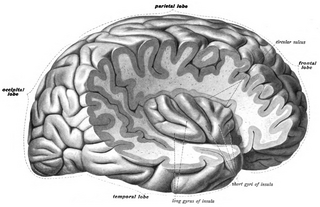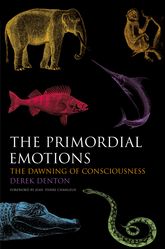
Emotions are mental states brought on by neurophysiological changes, variously associated with thoughts, feelings, behavioural responses, and a degree of pleasure or displeasure. There is currently no scientific consensus on a definition. Emotions are often intertwined with mood, temperament, personality, disposition, or creativity.
In normal language usage, the noun "feeling" is often used as being the same as emotion. However, in psychology, and in this article, feeling is used as a technical term which means a generalized bodily consciousness of a physiological sensation. It can be termed as a perception of physiological events within the body. Importantly, feeling is also termed as a self-contained physiological experience.
Developed in his (1999) book, The Feeling of What Happens, Antonio Damasio's three layered theory of consciousness is based on a hierarchy of stages, with each stage building upon the last. The most basic representation of the organism is referred to as the Protoself, next is Core Consciousness, and finally, Extended Consciousness. Damasio, who is an internationally recognized leader in neuroscience, was educated at the University of Lisbon and currently directs the University of Southern California Brain and Creativity Institute. Damasio's approach to explaining the development of consciousness relies on three notions: emotion, feeling, and feeling a feeling. Emotions are a collection of unconscious neural responses that give rise to feelings. Emotions are complex reactions to stimuli that cause observable external changes in the organism. A feeling arises when the organism becomes aware of the changes it is experiencing as a result of external or internal stimuli.

Thirst is the craving for potable fluids, resulting in the basic instinct of animals to drink. It is an essential mechanism involved in fluid balance. It arises from a lack of fluids or an increase in the concentration of certain osmolites, such as sodium. If the water volume of the body falls below a certain threshold or the osmolite concentration becomes too high, structures in the brain detect changes in blood constituents and signal thirst.

Antonio Damasio is a Portuguese-American neuroscientist. He is currently the David Dornsife Chair in Neuroscience, as well as Professor of Psychology, Philosophy, and Neurology, at the University of Southern California, and, additionally, an adjunct professor at the Salk Institute. He was previously the chair of neurology at the University of Iowa for 20 years. Damasio heads the Brain and Creativity Institute, and has authored several books: his next to latest work, Self Comes to Mind: Constructing the Conscious Brain (2010), explores the relationship between the brain and consciousness. Damasio's research in neuroscience has shown that emotions play a central role in social cognition and decision-making.

Descartes' Error: Emotion, Reason, and the Human Brain is a 1994 book by neuroscientist António Damásio describing the physiology of rational thought and decision, and how the faculties could have evolved through Darwinian natural selection. Damásio refers to René Descartes' separation of the mind from the body as an error because reasoning requires the guidance of emotions and feelings conveyed from the body. Written for the layperson, Damásio uses the dramatic 1868 railroad accident case of Phineas Gage as a reference for incorporating data from multiple modern clinical cases, enumerating damaging cognitive effects when feelings and reasoning become anatomically decoupled. The book provides an analysis of diverse clinical data contrasting a wide range of emotional changes following frontal lobe damage as well as lower (medulla) and anterior areas of the brain such as the anterior cingulate. Among his experimental evidence and testable hypotheses, Damásio presents the "somatic marker hypothesis", a proposed mechanism by which emotions guide behavior and decision-making, and positing that rationality requires emotional input. He argues that René Descartes' "error" was the dualist separation of mind and body, rationality and emotion.

The insular cortex is a portion of the cerebral cortex folded deep within the lateral sulcus within each hemisphere of the mammalian brain.

Affective neuroscience is the study of the neural mechanisms of emotion. This interdisciplinary field combines neuroscience with the psychological study of personality, emotion, and mood. The putative existence of 'basic emotions' and their defining attributes represents a long lasting and yet unsettled issue in the field.
Derek Ashworth Denton is an Australian scientist who explained the regulation of electrolytes in extracellular fluid, the hormones controlling this regulation, particularly aldosterone, and the instinctive behaviours controlling intake of water and salts. He was cited in 1995 at election to the U.S. National Academy of Sciences as the world’s leading authority on the regulation of salt and water metabolism and relevant endocrine control mechanisms. He is one of Australia’s most eminent scientists.
The theory of constructed emotion is a theory in affective science proposed by Lisa Feldman Barrett to explain the experience and perception of emotion. The theory posits that instances of emotion are constructed predictively by the brain in the moment as needed. It draws from social construction, psychological construction, and neuroconstruction.
One way of thinking holds that the mental process of decision-making is rational: a formal process based on optimizing utility. Rational thinking and decision-making does not leave much room for emotions. In fact, emotions are often considered irrational occurrences that may distort reasoning.

Frisson, also known as aesthetic chills or musical chills is a psychophysiological response to rewarding auditory and/or visual stimuli that often induces a pleasurable or otherwise positively-valenced affective state and transient paresthesia, sometimes along with piloerection and mydriasis. The sensation commonly occurs as a mildly to moderately pleasurable emotional response to music with skin tingling; piloerection and pupil dilation not necessarily occurring in all cases.
Jesse J. Prinz is a Distinguished Professor of philosophy and Director of the Committee for Interdisciplinary Science Studies at the Graduate Center of the City University of New York.
Primary consciousness is a term the American biologist Gerald Edelman coined to describe the ability, found in humans and some animals, to integrate observed events with memory to create an awareness of the present and immediate past of the world around them. This form of consciousness is also sometimes called "sensory consciousness". Put another way, primary consciousness is the presence of various subjective sensory contents of consciousness such as sensations, perceptions, and mental images. For example, primary consciousness includes a person's experience of the blueness of the ocean, a bird's song, and the feeling of pain. Thus, primary consciousness refers to being mentally aware of things in the world in the present without any sense of past and future; it is composed of mental images bound to a time around the measurable present.
Rosen Method Bodywork is a type of Complementary and alternative medicine. This bodywork, described as "psycho-somatic", claims to help integrate one's bodily and emotional/mental experience. In the tradition of sensory awareness methods, Rosen Method Bodywork focuses clients' attention onto internal sensations and emotions that arise as areas for the body are gently contacted with a "listening" touch. This means that the practitioner's goal is not to manipulate or fix clients but rather to notice areas of tension and stillness. The practitioner uses words to help clients become aware of these held places in the body and encourages clients to describe what they are feeling.

The Primordial Emotions: The Dawning of Consciousness is a 2006 book by the Australian neuroscientist Derek Denton.
Sham rage is behavior such as biting, clawing, hissing, arching the back and "violent alternating limb movements" produced in animal experiments by removing the cerebral cortex, which are claimed to occur in the absence of any sort of inner experience of rage. These behavioral changes are reversed with small lesions in hypothalamus.
Mirror-touch synesthesia is a rare condition which causes individuals to experience a similar sensation in the same part or opposite part of the body that another person feels. For example, if someone with this condition were to observe someone touching their cheek, they would feel the same sensation on their own cheek. Synesthesia, in general, is described as a condition in which a stimulus causes an individual to experience an additional sensation. Synesthesia is usually a developmental condition; however, recent research has shown that mirror touch synesthesia can be acquired after sensory loss following amputation.

Mindfulness has been defined in modern psychological terms as "paying attention to relevant aspects of experience in a nonjudgmental manner", and maintaining attention on present moment experience with an attitude of openness and acceptance. Meditation is a platform used to achieve mindfulness. Both practices, mindfulness and meditation, have been "directly inspired from the Buddhist tradition" and have been widely promoted by Jon Kabat-Zinn. Mindfulness meditation has been shown to have a positive impact on several psychiatric problems such as depression and therefore has formed the basis of mindfulness programs such as mindfulness-based cognitive therapy, mindfulness-based stress reduction and mindfulness-based pain management. The applications of mindfulness meditation are well established, however the mechanisms that underlie this practice are yet to be fully understood. Many tests and studies on soldiers with PTSD have shown tremendous positive results in decreasing stress levels and being able to cope with problems of the past, paving the way for more tests and studies to normalize and accept mindful based meditation and research, not only for soldiers with PTSD, but numerous mental inabilities or disabilities.

Interoception is contemporarily defined as the sense of the internal state of the body. This can be both conscious and non-conscious. It encompasses the brain's process of integrating signals relayed from the body into specific subregions—like the brainstem, thalamus, insula, somatosensory, and anterior cingulate cortex—allowing for a nuanced representation of the physiological state of the body. This is important for maintaining homeostatic conditions in the body and, potentially, facilitating self-awareness.













